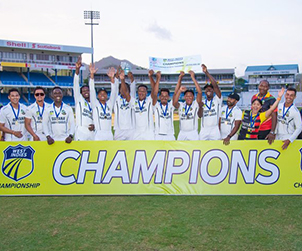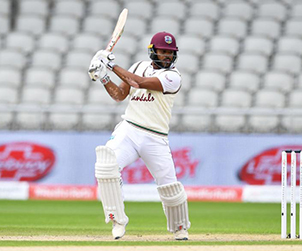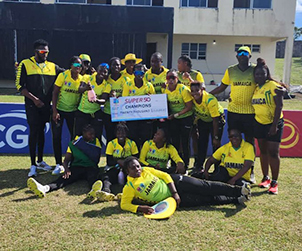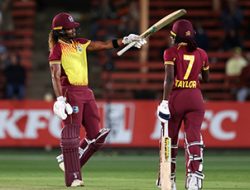A kicking, screaming short ball, too fast and too close to the batsman for a proper response. Was he cutting, punching, or defending? It seemed an awkward and only partially intentional combination of all three, and before he knew it Virat Kohli was gone, caught at first slip.
Two genuine quicks sharing the new ball, another waiting to bowl. A fast, bouncy pitch, and a picturesque backdrop, in this case the Beausejour Hills with a manually operated scoreboard in front of it, saying 19 for 2. This, belatedly, was an echo of the West Indies that cricket fans have known and loved.
Miguel Cummins had been in the squad since the first Test, but had only been part of their attack since the second. Alzarri Joseph had been in the squad since the second Test, but was only now making his debut, and was only now getting to bounce out India’s captain and best batsman. On the final day of the Sabina Park Test, West Indies had glimpsed a middle order with the potential to serve them for a long time. Now they were seeing, possibly, a pace attack take shape.
Shannon Gabriel had struck first getting Shikhar Dhawan caught down the leg side, experiencing the stroke of luck his bowling has deserved all series. At the other end, Joseph gave the world a first glimpse – at senior level – of the effortless pace his lanky, loose-limbed frame could generate. He greeted Kohli with a bouncer that left him on his backside, foreshadowing the dismissal that was to come.
Later, Cummins would come on and bowl just as quick, almost none of his pace coming from his shuffling run-up and almost all of it generated by the final thrust of shoulder and arm, and attack the throats of KL Rahul and Ajinkya Rahane. They popped three balls in the general direction of short leg. There was no fielder in place the first time, and the ball eluded him narrowly the next two times. India, playing with only five batsmen for the third time in the series – and on this occasion shuffling two of them out of position – were being seriously tested for the first time, from both ends, with little respite.
It wasn’t all short and brutal. In the second session, West Indies’ seamers came out with an entirely different plan, and tested India’s patience in the corridor. Jason Holder, who has done this all series, was expected to bowl this way, but perhaps not Joseph in his first Test. He bowled eleven straight dot balls to Rohit Sharma after lunch, the bulk of them outside off stump, on a good length or just short of it, and bat came feeling for ball against the 12th ball, which straightened just enough to take the edge.
West Indies had three genuine fast bowlers and a medium-paced fourth seamer, and all of them were doing their bit. They were bowling on the quickest surface of the series. Yet, by the end of the day, their busiest bowler was their offspinner, Roston Chase. At stumps, his figures read 23-8-38-2.
Shortly before lunch, Chase had dismissed Rahul against the run of play. His best work, however, came between lunch and tea, when he sent down an eight-over spell that only cost his side nine runs and built enough frustration to pry out India’s last specialist batsman, Rahane.
In that spell, Chase bowled quickish offbreaks on a stump-to-stump line, with the leg side heavily guarded. The six leg-side fielders were, typically, a short leg, a mid-on who would occasionally drop back to long-on, two midwickets – one straighter and close to the bat, the other squarer and slightly deeper – square leg and short fine leg. The only fielders on the off side were mid-off, extra cover and slip.
Given the situation they were in, and Chase’s line, India couldn’t risk the sweep, particularly on a bouncy pitch with short fine leg waiting for the top edge. This allowed West Indies to suffocate India further with square leg saving the single rather than stationed on the boundary.
Of the 39 balls Chase bowled to Rahane and R Ashwin between lunch and tea, the batsmen played 20 into the leg side, for five runs, and 18 into the off side – 15 of them either towards mid-off or cover – for four runs. Chase hardly overpitched, and almost never dropped short enough to cut through the vacant region stretching from point to third man, or to pull over square leg.
Something had to give and it was Rahane’s patience. Over the course of Chase’s spell, he had gone from 32 off 96 balls to 35 off 132. Out came the sweep, against a slow, loopy delivery that was a full toss if he hit it and a yorker if he missed. It was either the wrong ball for the sweep – its steep downward trajectory minimising the horizontal bat’s margin for error – or just poor execution. The ball dipped, eluded Rahane’s bat, and bowled him. India were 126 for 5.
On a first-day pitch with little help for his offspin, Chase had done far more than anyone may have expected. He gave nothing away, bowled more overs than anyone else, and allowed the quicks to bowl shorter, sharper spells.
West Indies may have found a group of promising fast bowlers, though no one at this stage would be silly enough to compare any of them to the greats of the 1980s. But they may just have unearthed a tall, restrictive offspinner not unlike Roger Harper. In the West Indies side he played for, Harper only needed to bowl around 15 overs an innings, but performed that task admirably, ending up as his team’s most economical bowler of the 80s while maintaining a sub-30 bowling average.
On Tuesday’s evidence, Chase could do a similar job with the ball while offering far more with the bat. If West Indies build on the promise of their fast bowlers, they might yet assemble a consistently dangerous Test-match attack.






















